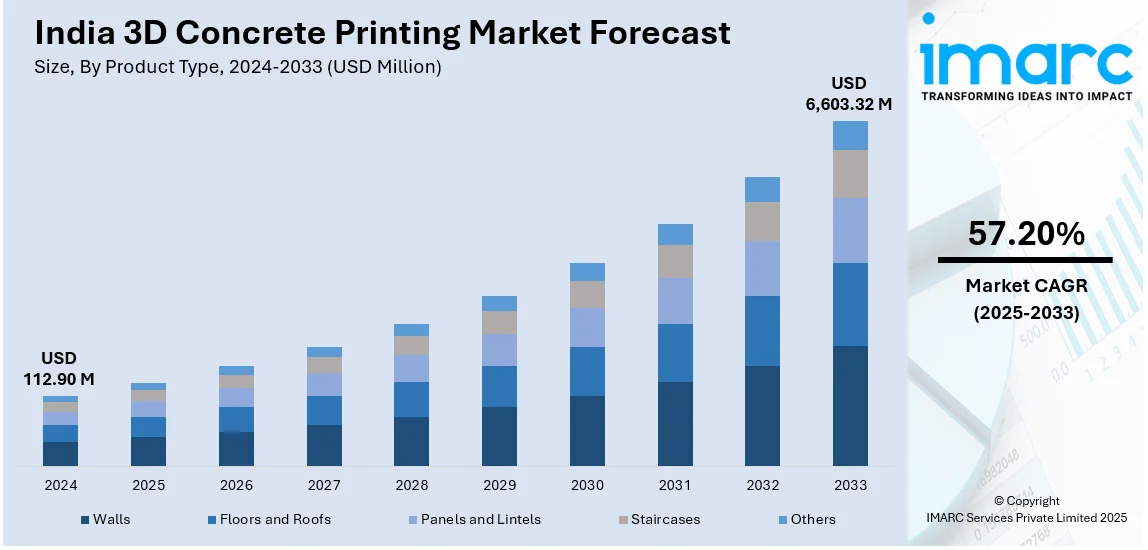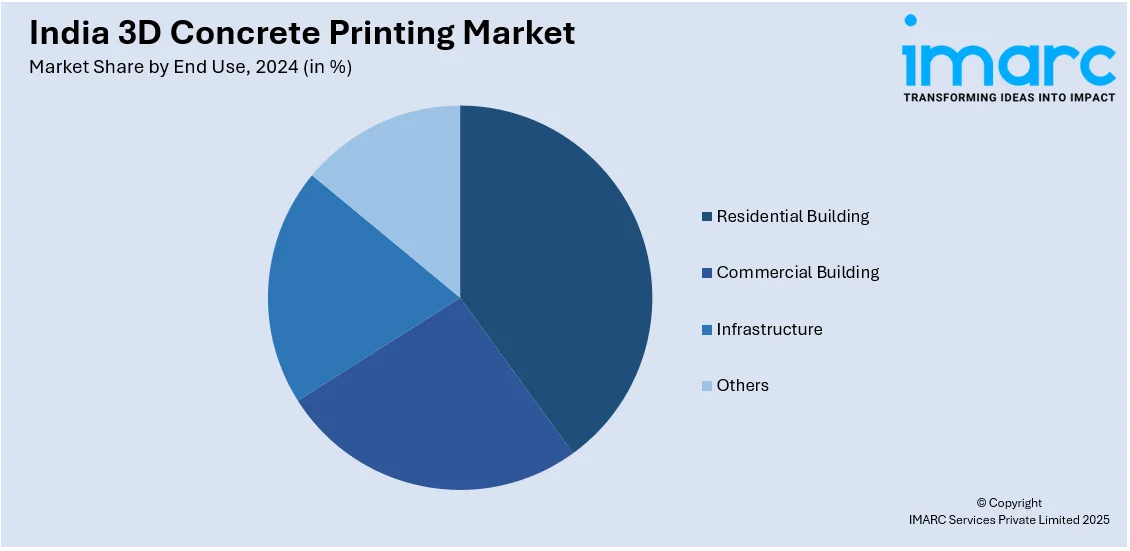
India 3D Concrete Printing Market Size, Share, Trends and Forecast by Product Type, Concrete Type, Printing Type, End Use, and Region, 2025-2033
India 3D Concrete Printing Market Overview:
The India 3D concrete printing market size reached USD 112.90 Million in 2024. Looking forward, IMARC Group expects the market to reach USD 6,603.32 Million by 2033, exhibiting a growth rate (CAGR) of 57.20% during 2025-2033. India’s 3D concrete printing market is expanding with advancements in automated construction and sustainable building solutions. In line with this, faster project completion, reduced costs, and resource efficiency are positioning 3D printing as a transformative construction technology, further favoring market growth.
|
Report Attribute
|
Key Statistics
|
|---|---|
|
Base Year
|
2024 |
|
Forecast Years
|
2025-2033
|
|
Historical Years
|
2019-2024
|
| Market Size in 2024 | USD 112.90 Million |
| Market Forecast in 2033 | USD 6,603.32 Million |
| Market Growth Rate (2025-2033) | 57.20% |
India 3D Concrete Printing Market Trends:
Advancements in Automated Construction Technology
India's 3D concrete printing industry is undergoing a speedy revolution with the adoption of automated construction technologies. The growing need for quicker, cheaper, and more accurate construction solutions is compelling businesses to embrace sophisticated robotics and automation. 3D concrete printing minimizes labor dependency to a higher extent, improves structural strength, and shortens project completion timelines. Furthermore, these technologies also provide improved resource utilization and reduced material wastage, making construction more efficient. In March 2025, L&T Construction successfully 3D printed a 700 sq. ft. G+1 house at its Kanchipuram facility using an automated 3D printer and a reinforced concrete mix. The project highlights how automated construction can support India’s affordable housing initiatives by delivering high-quality structures at a faster pace. Moreover, the utilization of advanced computer-aided designs and layer-by-layer automated printing guarantees structural strength at lower costs. Similarly, the implementation of automated 3D concrete printing is poised to transform India's construction industry by increasing project efficiency and minimizing conventional construction constraints. With increased urbanization and government encouragement of technology-based infrastructure development, this trend is poised to grow even larger, establishing India as a major player in the international 3D concrete printing market. The ongoing development in robotic printing, design automation using AI, and materials development will further establish India as a leader in automated construction.

To get more information on this market, Request Sample
Growing Investments in Sustainable Building Solutions
The need for green and sustainable construction is gaining traction in India's 3D concrete printing industry. In the wake of mounting concerns related to construction waste, energy utilization, and carbon footprints, firms are putting their money on research and development in order to establish sustainable solutions for buildings. Along with this, with 3D concrete printing merged with environmentally friendly materials and designs that maximize performance, carbon footprints are reduced, raw materials usage decreases, and energy efficiency is enhanced. Further, sustainable innovation represents the most powerful stimulus for growth in the market. For example, in June 2024, Tvasta Manufacturing Solutions inaugurated Kerala’s first Concrete 3D Printing Research Lab at Saintgits College of Engineering, Kottayam. The lab, equipped with NIRMAAN RD11, is designed to advance research in eco-friendly construction methodologies. It is focused on creating durable concrete mixes, reducing energy usage, and recycling industrial byproducts for construction use. It enhances India's R&D capabilities in 3D concrete printing while advancing green construction practices. The rising investment in green 3D printing technologies will redefine India's construction industry. As policymakers and developers focus more on green construction methods, 3D printing of concrete will be at the forefront of shrinking the environmental footprint while enhancing building efficiency. This technology will create mass adoption within infrastructure development programs, making India a hub of sustainable construction systems. The commitment of the sector towards green building materials, integrating circular economy in operations, and energy-efficient infrastructure will also make long-term prospects in the market more vibrant.
India 3D Concrete Printing Market Segmentation:
IMARC Group provides an analysis of the key trends in each segment of the market, along with forecasts at the region/country level for 2025-2033. Our report has categorized the market based on product type, concrete type, printing type, and end use.
Product Type Insights:
- Walls
- Floors and Roofs
- Panels and Lintels
- Staircases
- Others
The report has provided a detailed breakup and analysis of the market based on the product type. This includes walls, floors and roofs, panels and lintels, staircases, and others.
Concrete Type Insights:
- Ready-mix
- High-density
- Precast
- Shotcrete
- Others
The report has provided a detailed breakup and analysis of the market based on the concrete type. This includes ready-mix, high-density, precast, shotcrete, and others.
Printing Type Insights:
- Gantry System
- Robotic Arm
A detailed breakup and analysis of the market based on the printing type have also been provided in the report. This includes gantry system and robotic arm.
End Use Insights:

- Residential Building
- Commercial Building
- Infrastructure
- Others
A detailed breakup and analysis of the market based on the end use have also been provided in the report. This includes residential building, commercial building, infrastructure, and others.
Region Insights:
- North India
- South India
- East India
- West India
The report has also provided a comprehensive analysis of all the major regional markets, which include North India, South India, East India, and West India.
Competitive Landscape:
The market research report has also provided a comprehensive analysis of the competitive landscape. Competitive analysis such as market structure, key player positioning, top winning strategies, competitive dashboard, and company evaluation quadrant has been covered in the report. Also, detailed profiles of all major companies have been provided.
India 3D Concrete Printing Market News:
- February 2025: Tvasta, an IIT-Madras incubated startup, completed India’s first 3D-printed villa in Pune for Godrej Properties, showcasing automated construction, faster completion, and energy-efficient design. This milestone advances 3D concrete printing adoption, promoting sustainability, reduced costs, and enhanced efficiency in India’s construction sector.
- February 2025: Godrej Properties completed a 3D-printed ground-plus-one villa at Godrej Eden Estate, Pune, with Tvasta Engineering, demonstrating speed and efficiency. L&T, in August 2024, delivered six 3D-printed villas in Bengaluru. These projects highlight faster construction, cost efficiency, and growing market adoption in India.
India 3D Concrete Printing Market Report Coverage:
| Report Features | Details |
|---|---|
| Base Year of the Analysis | 2024 |
| Historical Period | 2019-2024 |
| Forecast Period | 2025-2033 |
| Units | Million USD |
| Scope of the Report |
Exploration of Historical Trends and Market Outlook, Industry Catalysts and Challenges, Segment-Wise Historical and Future Market Assessment:
|
| Product Type Covered | Walls, Floors and Roofs, Panels and Lintels, Staircases, Others |
| Concrete Type Covered | Ready-mix, High-density, Precast, Shotcrete, Others |
| Printing Type Covered | Gantry System, Robotic Arm |
| End Use Covered | Residential Building, Commercial Building, Infrastructure, Others |
| Regions Covered | North India, South India, East India, West India |
| Customization Scope | 10% Free Customization |
| Post-Sale Analyst Support | 10-12 Weeks |
| Delivery Format | PDF and Excel through Email (We can also provide the editable version of the report in PPT/Word format on special request) |
Key Questions Answered in This Report:
- How has the India 3D concrete printing market performed so far and how will it perform in the coming years?
- What is the breakup of the India 3D concrete printing market on the basis of type?
- What is the breakup of the India 3D concrete printing market on the basis of lease type?
- What is the breakup of the India 3D concrete printing market on the basis of service provider type?
- What is the breakup of the India 3D concrete printing market on the basis of tenure?
- What are the various stages in the value chain of the India 3D concrete printing market?
- What are the key driving factors and challenges in the India 3D concrete printing market?
- What is the structure of the India 3D concrete printing market and who are the key players?
- What is the degree of competition in the India 3D concrete printing market?
Key Benefits for Stakeholders:
- IMARC’s industry report offers a comprehensive quantitative analysis of various market segments, historical and current market trends, market forecasts, and dynamics of the India 3D concrete printing market from 2019-2033.
- The research report provides the latest information on the market drivers, challenges, and opportunities in the India 3D concrete printing market.
- Porter's five forces analysis assist stakeholders in assessing the impact of new entrants, competitive rivalry, supplier power, buyer power, and the threat of substitution. It helps stakeholders to analyze the level of competition within the India 3D concrete printing industry and its attractiveness.
- Competitive landscape allows stakeholders to understand their competitive environment and provides an insight into the current positions of key players in the market.
Need more help?
- Speak to our experienced analysts for insights on the current market scenarios.
- Include additional segments and countries to customize the report as per your requirement.
- Gain an unparalleled competitive advantage in your domain by understanding how to utilize the report and positively impacting your operations and revenue.
- For further assistance, please connect with our analysts.
 Request Customization
Request Customization
 Speak to an Analyst
Speak to an Analyst
 Request Brochure
Request Brochure
 Inquire Before Buying
Inquire Before Buying




.webp)




.webp)












